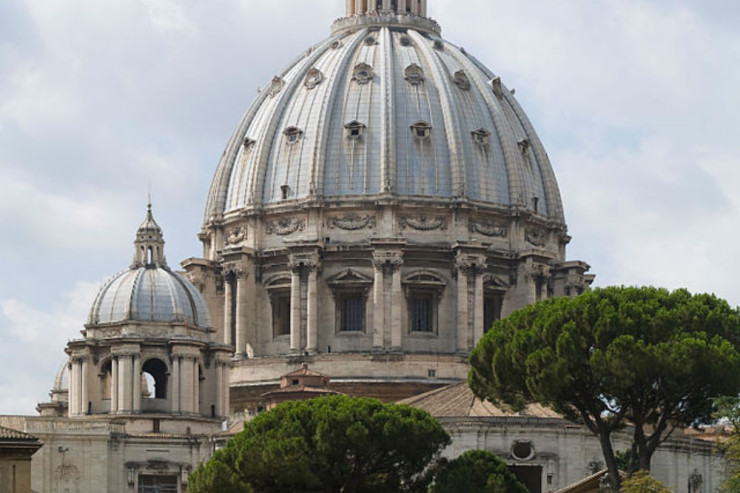Answered by Legionary of Christ Father Edward McNamara, professor of liturgy and dean of theology at the Regina Apostolorum university.
Q: At the beginning of Mass, the priest says the words, «May Almighty God have mercy on us, forgive us our sins, and bring us to eternal life.» The rubric in the missal states absolution. Is this really an absolution, and should the priest make the sign of the cross? Does it truly reflect forgiveness of sin? — L.B., San Diego, California
A: The General Instruction of the Roman Missal (GIRM) says the following in No. 51:
«Then the priest invites those present to take part in the Act of Penitence, which, after a brief pause for silence, the entire community carries out through a formula of general confession. The rite concludes with the priest’s absolution, which, however, lacks the efficacy of the Sacrament of Penance.»
The rubrics make no indication that the priest makes the sign of the cross and therefore, since such gestures are always indicated at other moments, it is to be supposed that this is not done.
In the extraordinary form the Confiteor is said twice, first by the priest and then by the server.
After the priest has said the Confiteor, the server addresses him saying:
«May Almighty God have mercy upon you, forgive you your sins, and bring you to life everlasting.»
The priest then says the prayer Indulgentiam:
«May the Almighty and merciful God grant us pardon [he makes the sign of the cross] absolution, and remission of our sins.»
Once more, this formula is not a sacramental absolution but a petition for remission so as to worthily celebrate the mysteries of the Mass.
In spite of the fact that the word “absolution” is used, the formula does not have sacramental effect and does not directly forgive sins. Several conditions normally required for sacramental absolution are missing, such as an explicit confession of at least one concrete sin. Likewise, in the extraordinary form at least, the words are said only over the server and are not intended to be sacramental.
Some form of acknowledgment of our sinful state has formed part of the initial rites from very early times. In Rome, for example, this was done silently by the celebrant and ministers kneeling or prostrating themselves before the altar. Words were added to this silent gesture in Frankish territory (mostly modern-day France and Germany) during the eighth century.
At first the Confiteor was an individual expression; however, from around the 11th century it had generally become a form of dialogue in which the priest recognizes his sinfulness not only before God and heaven but also before those around him and asks for their intercession. This intercession is offered, as can be seen in the formula of the server in the extraordinary form above.
The actual form and method of praying the Confiteor was probably taken from the Divine Office, in particular from the offices of prime and compline, and introduced into the beginning of the Mass. It was in this transfer that the two formulas, the Misereatur, or layman’s intercessory response, and the Indulgentiam, or priest’s formula, were first introduced and became a stable part of the Mass around the year 1000.
This switch was aided by the fact that during this period the formula Indulgentiam, often beginning with the second word “absolutionem,” also served for a time as sacramental absolution during confession. Likewise it was by then becoming common to impart the absolution immediately after sacramental confession, as is the norm today, and not after completion of a time of penance as was the earlier practice. It thus became natural to append the absolution formula to the Confiteor as was customary. This furthermore explains why the sign of the cross accompanies the Indulgentiam in the extraordinary form as it was also used for sacramental absolution.
There have been several formulas for the Confiteor and Misereatur during Mass. Some invoked more saints, some listed types of sins. The advent of scholastic theology clarified sacramental notions and made necessary distinctions between the sacraments and their efficacy. As a result these additions were generally disapproved by contemporary theologians and pastors as it undermined the nature of the Confiteor as a public general confession and not a secret private one. Thus, the third Council of Ravenna in 1314 decreed that aside from Mary, only Michael, John the Baptist and saints Peter and Paul were to be invoked.
Therefore, the rites of the extraordinary form contain pre-scholastic elements that might induce some to believe that the rite was of a sacramental nature. In fact, this error rarely occurs, and the ceremonies serve as a reverent preparation for the celebration of Mass.
The formula of the Confiteor in the ordinary form has been simplified and now mentions only Mary by name. It has also been transformed into a community prayer rather than a dialogue between priest and server at the foot of the altar. The formula Misereatur hitherto said by the server is now transferred to the priest who intercedes for all present.
The sign of the cross is no longer made so as to remove any ambiguity as to the non-sacramental nature of this rite.
* * *
Readers may send questions to zenit.liturgy@gmail.com. Please put the word «Liturgy» in the subject field. The text should include your initials, your city and your state, province or country. Father McNamara can only answer a small selection of the great number of questions that arrive.

Wikimedia Commons
Penitential Rite and "Absolution"
Formula Doesn’t Have Sacramental Effect


